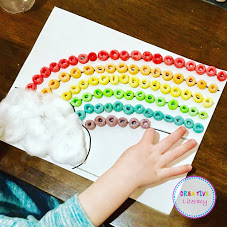We love dramatic play. It's one of our favorite activities. One of the best things we did this year was create a pumpkin patch. Naturally, that somehow morphed into a Pumpkin Patch/Stand/Kitchen combo...
We typically study pumpkins in November. We like to keep our pumpkins as decor through Thanksgiving and October is usually full of spiders, bats, witches, etc, so this is the perfect time for a pumpkin study!
Our patch was filled with different sized pumpkins, hay, and sunflowers to pick and buy! We used plastic pumpkins and painted paper bag pumpkins here, but you can also use real pumpkins!
I created the vines using twisted tissue paper and added cardstock leaves, chenille stem tendrils, and small pumpkins.
We also "sold" real gourds and dried ornamental corn in our patch. Using real objects is something I feel strongly about because it makes those real life connections. Also, those gourds and corn have the coolest colors and textures to observe!
Our patch included a "Pick Your Own Apples" felt tree. I attached the plastic apples with hook and loop circles this year, but they didn't stick as well as I hoped. I think I will sew the hook onto the felt and try to glue the loop end to the apples next year.
Our grocery store was easily turned into a Pumpkin Stand selling all kinds of pumpkin themed treats like pancakes, bread, cookies, and lattes. Most of the food was repurposed from our regular kitchen food.
I did make this adorable felt pie from a cake pattern I adjusted. The pattern can be found here, and it turned out so cute! I just replaced the back and bottom of the cake with tan felt and added a strip of crust to the top. I only planned on making two or three pieces, but we are talking about fractions so I ended up making all 8 because who doesn't love using food to teach math?
We also added some gifts to our stand. The candy was so easy to make and my six year old loved helping!. We twisted orange tissue paper around cotton balls, put them into a jar, and tied a pretty ribbon on it.
We all had an amazing time playing in this area. They had a blast cooking and shopping, and I had so much fun seeing what they came up with!
If you would like to set up your own pumpkin-themed dramatic play center, you can find my printables in my Teachers Pay Teachers store here. It includes all the labels and signs you see in the pictures, plus printable money and job tags. It also includes instructions, ideas, and even more pictures of our pumpkin patch/stand/kitchen!






















































